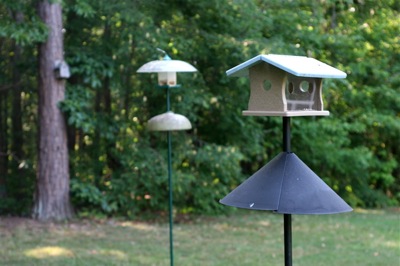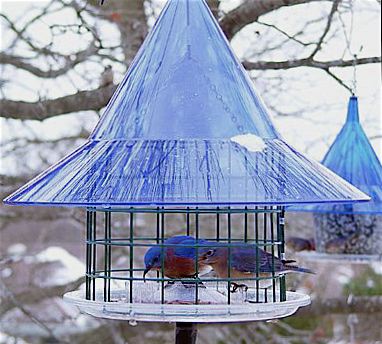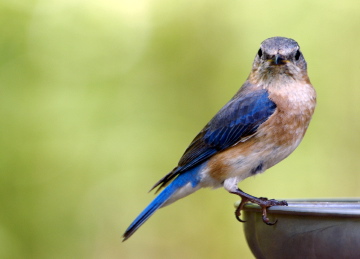- Bird Accessories, Bird Feeders, Bluebird Feeders, Fruit, Jelly & Mealworm Feeders, Live Meal Worms, Mealworm Feeder, Uncategorized
nasty yellow jackets at the mealworm feeder
Lots of bluebirds have passed through this mealworm feeder in our back yard. Last season we had three successful broods of Eastern Bluebirds, in part, thanks to a welcoming habitat. Even the Chickadees, Carolina Wrens and Titmice have learned to use this fly-in mealworm feeder with ease… which I’m not sure is such a good thing? Worms are really reserved for our bluebirds only! This traditional type bluebird feeder is made from recycled plastic, and although it’s about five years old now, it still looks and acts the same way as when it was first installed. With so much junk out there, who doesn’t like quality stuff!
What I am sure of that’s not a good thing are the yellow jackets who continue to torture the live worms inside the feeder! When, for heaven’s sake is it time for them to die off? Every morning when I go to add worms for the patiently waiting, eager bluebirds… the yellow jackets are in there munching on worm remains.
Last night it was in the 20’s here in North Georgia, and finally this morning none of the nasty jax were seen! The weather here is crazy though, hot, cold, warm cold, even some bulbs started forcing their way through the ground with the last dip in temperatures.
I can only hope with this last frost, that all yellow jackets are gone for the season! I think the birds will be happy too 🙂
-
Innovative mealworm feeder
Waaay cool, the makers of the Sky Cafe have created a mealworm feeder specifically for bluebirds. The new Sky Cafe is totally squirrel proof for starters. The design will keep larger birds out, thus saving precious mealworms for your bluebirds. The large baffle, or hat, also protects food and birds from the elements. A high quality mealworm feeder that may be pole mounted or hung, you know will be around for many years of use and enjoyment
There are lots of groovy dish-type mealworm feeders out there, but as soon as birds discover the tasty morsels, the worms will disappear in no time flat! Seems lots of birds love mealworms… especially live ones.
If you’re forever running to the store in order to keep your mealworm feeder filled, you may want to consider buying them in bulk. It’s far more economical if you’re feeding live worms. Stored in the fridge, the worms stay in a dormant state until they’re warmed up, so no worries of creepy-crawly things in your fridge! The bedding used is nothing more than wheat bran, purchased at your local grocery store.
If you’ve been trying to attract bluebirds with no luck…live worms are the ticket! Bluebirds seem to find this precious food source quickly, and will stick around if mealworms are fed on a consistent basis. Our bluebirds have braved the tough winters of North Georgia for the past few years now… ever since their mealworm feeder is always stocked with live worms. The heated baths help too, and it’s got to be this combination that has allowed us to witness so many successful broods!
Here’s to spring!
- Bird Accessories, Bird Feeders, Bluebird Feeders, Fruit, Jelly & Mealworm Feeders, Live Meal Worms, Mealworm Feeder, Uncategorized
Try a Mealworm Feeder for Bluebirds
In order to entice bluebirds, sometimes their very favorite food must be offered. And meal worms happen to be what’s on the menu over here. Live mealworms are best, but dried or roasted ones will also work. One of the problems is that many species really enjoy mealworms, and you can find your supply dwindling quickly if fed in an open tray-type or dish feeder. Live mealworms are available in bulk quantities should this become habit forming too. They’re simple to store…just place in in a container in your fridge. Air holes are needed, but the worms stay in a dormant state until warmed up by the sun or room temperatures.
A mealworm feeder that’s made especially for bluebirds is one that is enclosed, in fact they’re called Bluebird Feeders. Consisting of two, four, or sometimes six entrances, they have clear acrylic panels for closures, and they’re meant for bluebirds only. Some feeders have a dish in the center for the worms, while others have a recessed circle for them. The birds must fly into the feeder to retrieve the worms, and very few species will try this. But somehow, the natural instinct of bluebirds tells them to do so.
It’s amazing to watch, especially when parent bring babies over at feeding time. At first the chicks don’t understand how to get inside, but they learn quickly. And once they learn how to get the food, they frequent the feeder often. This has got to be one of the best scenes of backyard birding!
Available in standard wooden models, mealworm feeders also come in recycled plastic versions. The advantage with
recycled plastic is that the feeder will never crack, split, or rot like wood tends to do over the years. Also keeping plastics out of landfills is huge plus to the environment.
Now I wish the nasty starling who tried to shove himself through one of the entrances would’ve gotten stuck there!





